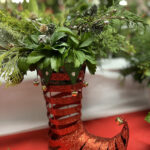Mulching
- Mulch is an option around your seedlings to conserve moisture and deter weeds. Use straw, grass clippings, or shredded leaves for easy organic mulch. You can find additional information on mulching a vegetable garden at https://getbusygardening.com/mulching-vegetable-garden/
Watering
- Water immediately after transplanting your seedlings, and for seeds water whenever necessary to keep them moist. To avoid washing away your seeds, use a fine spray.
- Remember that plants in grow bags and containers require more water than in-ground plants.
- Seeds and seedlings generally need water every 1 to 2 days. They grow best with a consistent and even supply of moisture where the soil is neither soggy nor dry.
- For grow bags and containers, check the soil on a daily basis. Water anytime you see that the soil is drying out or if it feels dry when you insert your finger about two inches into the soil.
- Sometimes you will have to water twice a day, especially as your plant gets bigger and the weather becomes warmer.
- Do not water the foliage – water the soil around the “drip line”, which is the outer edge of the plant, or the point where water would drip from the outer leaves.
Tip: The best time of day to water seeds and seedlings is in the morning.
- Water immediately if the plant droops and withers! Young seedlings are very susceptible to water variations and will quickly droop if they don’t have enough water.
Fertilizing
- For seeds, follow seed packet recommendations for fertilizing. With some plants, seed packages may recommend feeding with a diluted fertilizer for the first month or so, until the plants are strong enough to tolerate full-strength feeding. For others, delay fertilization until the seed-started plant begins to set flower buds.
- For transplanted seedlings, fertilize a few days after they’ve been transplanted.
- Apply fertilizer during watering.
- Fertilize regularly during the growing season.
- Plants grown in grow bags typically require more fertilizer (and water) because they are very porous.
- Here is additional information on fertilizing vegetable gardens.
Weeding
- Be diligent in weeding around your young seedlings. Weeds compete for water, sunlight, and nutrients, so regular weeding is necessary.
- Know what your seedlings look like to ensure you won’t pull them by mistake while weeding.
- Wait for a set or two of true leaves to appear to help you identify your plants. There are websites you can reference to see what certain seedlings look like. Some seed packets have photos or drawings on them.
Thinning
- Your seedlings may require thinning. This is especially true of tiny seeds. If allowed to grow too close, they won’t be able to mature into sizable plants, so shortly after the seeds sprout, start thinning.
- Follow the seed packet’s recommendations for proper spacing between plants, and make sure to thin gently to avoid disturbing the fragile new roots of adjoining plants.
Tip: rather than thinning by pulling seedings from the ground, pinch or snip them off at ground level
- You may need to thin a second time as the plants grow larger and begin to crowd one another. For some vegetables, what you pluck out may be edible – as in tiny carrots or radishes.
Check the Framingham Garden Club website frequently as we add additional resources and information https://framinghamgardenclub.org/resources-information/





